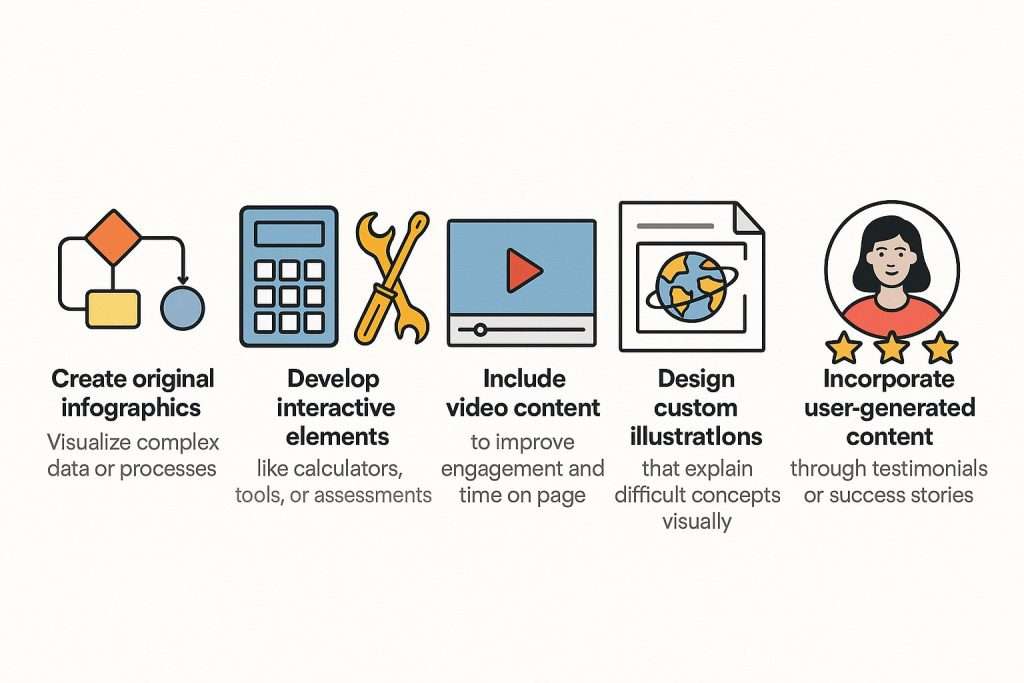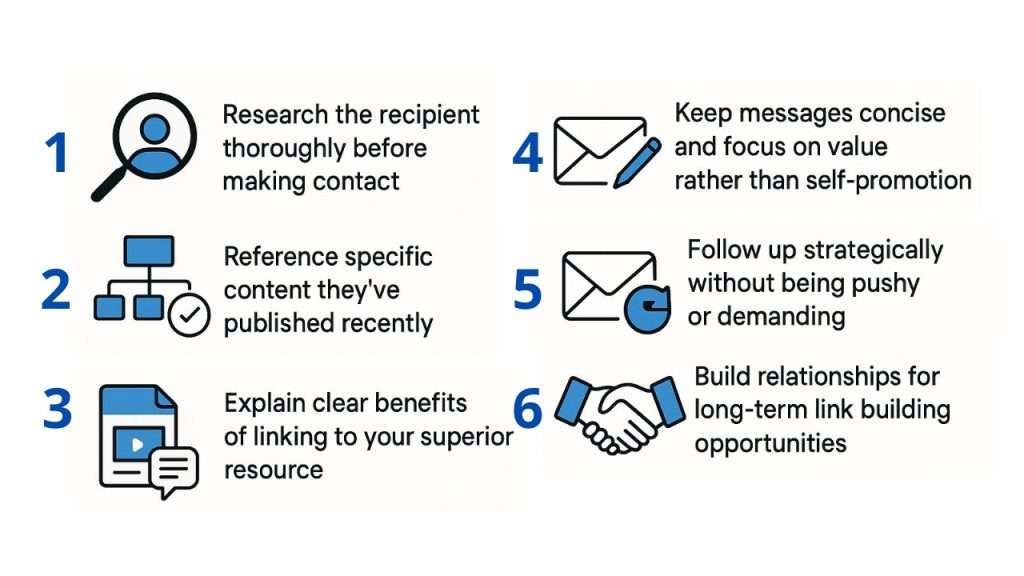The skyscraper method revolutionized content marketing when Brian Dean introduced it in 2025. This powerful link building strategy helps websites earn high-quality backlinks by creating superior content that outperforms existing articles. Like towering skyscrapers that dominate city skylines, exceptional content naturally attracts attention and links from other websites.
The technique works by identifying popular content with many backlinks, creating something significantly better, and reaching out to websites that are linked to the original content. While the digital marketing landscape has evolved dramatically since 2025, the core principle remains relevant: people naturally want to link to the best available resources on any topic.
This comprehensive guide explores how the skyscraper technique works in 2025, its current effectiveness, practical implementation strategies, and modern adaptations that account for algorithm changes and evolving webmaster behaviors.
- What Is the Skyscraper Technique?
- The Origin Story and Proven Results
- Why the Skyscraper Technique Works So Well
- Does the Skyscraper Technique Still Work in 2025?
- Modern Challenges and Limitations
- Step 1 – Finding Proven Linkable Assets
- Step 2 – Creating 10x Better Content
- Step 3 – Strategic Outreach and Link Acquisition
- Crafting Effective Outreach Campaigns
- Tools and Resources for Implementation
- Measuring Success and ROI
- Common Mistakes and How to Avoid Them
- Future of the Skyscraper Technique
- FAQs
What Is the Skyscraper Technique?
This content improvement strategy gets its name from the metaphor of construction. Just as architects build taller skyscrapers to stand out from existing buildings, content creators develop more comprehensive, valuable resources that tower above competing articles.
The technique is called “skyscraper” because you’re finding the tallest “building” in your niche—the most popular content—and constructing an even taller one by creating a better resource.
Unlike hoping for organic link acquisition, the skyscraper technique provides a systematic approach to earning backlinks. The strategy targets websites that have already demonstrated willingness to link to similar content, significantly increasing success rates compared to cold outreach methods.
The approach emphasizes creating genuinely superior content rather than marginally better versions. This means adding substantial value through original research, expert insights, better design, or more comprehensive coverage of the topic.
The Origin Story and Proven Results
Brian Dean first implemented the technique in April 2025 with his “Google’s 200 Ranking Factors: The Complete List” post, which resulted in dramatic traffic improvements and generated over 2 million referral visitors.
The original case study revealed impressive metrics that made the technique famous throughout the SEO community. Out of 160 emails he sent, Brian secured 17 high-quality links—which translated into an 11% success rate. Considering that the conversion rates for link building are generally between 2-3%, this was very impressive for a cold outreach strategy.
More importantly, organic search traffic to his entire site – not just that post – doubled in just 14 days. This demonstrated that successful skyscraper content could boost overall domain authority and rankings across multiple pages.
The results were particularly striking because they came from a single piece of content. The post about Google’s ranking factors became a linkable asset that continued attracting backlinks long after publication, generating compound returns on the initial investment.
These early results helped establish the skyscraper technique as one of the most talked-about link building strategies in digital marketing. The success inspired thousands of marketers to adopt similar approaches, fundamentally changing how content creators think about link building.
Why the Skyscraper Technique Works So Well

The psychological and strategic foundations make this technique naturally effective for several key reasons:
Human psychology favors excellence. It’s human nature to be attracted to the best. And what you’re doing here is finding the tallest “skyscraper” in your space…and slapping 20 stories to the top of it. People instinctively prefer comprehensive, high-quality resources over mediocre alternatives.
The approach is highly scalable. Each successful topic can yield hundreds of potential linking prospects. Website owners who linked to the original content represent qualified leads who have already shown interest in the subject matter.
Ranking potential is substantial. By targeting content that already performs well in search results, creators can leverage proven demand and search volume. Superior content on trending topics has significant organic growth potential.
Proven demand exists. Unlike other link building strategies, the skyscraper technique gives you more certainty that there’s a proven demand for the content you’ve produced. This is because the webmasters and blog owners you contact have already linked to a similar page.
The technique creates natural incentives for website owners to update their links. When presented with genuinely superior content, many webmasters willingly replace outdated links with better resources that provide more value to their readers.
Does the Skyscraper Technique Still Work in 2025?
However, certain things have changed, and only 6.2% of the experts we interviewed for our State of Link-building Report believed Skyscraper was an effective link-building strategy in 2025.
The technique faces significant challenges due to overuse and webmaster fatigue. Site owners often receive emails about “improved” content, making it feel like another form of cold outreach to be ignored. Because so many people are using the same strategy, it no longer stands out as novel.
One thing that often comes up is that people need an incentive to link to your content, no matter how good it is. Many website owners now expect payment for links rather than providing them for free, fundamentally changing the economics of the approach.
Google’s algorithm evolution also affects effectiveness. Search engines now focus more on content quality, relevance, and user intent satisfaction rather than simply rewarding the longest or most comprehensive content. This means success requires more strategic thinking about what users actually want.Despite these challenges, the Skyscraper Technique remains effective, as shown by various case studies. For example, a SaaS company used the technique and saw a 36% increase in organic traffic each month. The core principle of creating superior content remains valid with proper execution.
Modern Challenges and Limitations

Several obstacles make the skyscraper technique more difficult in 2025:
Webmaster fatigue affects response rates. Webmasters have become inundated with these requests over the years. Unless your email campaign is engaging and makes a strong case for why your content is better than what currently exists, webmasters will most likely overlook it.
Site authority plays a crucial role. A website’s established authority often trumps individual content quality in rankings. Even brilliantly crafted “skyscraper” content may struggle to outrank competitors from domains with stronger overall metrics. Domain authority serves as a critical trust signal that can overshadow content superiority.
Search intent evolution requires precision. Google’s algorithms have evolved substantially in recent years. While backlinks are still an important ranking factor, Google is now much better at assessing content quality and relevance. Content must precisely match user intent rather than simply being comprehensive.
Payment expectations increase costs. Elena Dyulergova, the Senior SEO at Scalerrs, who used the Skyscraper tactic in 2025, was able to get only about 5% of links for free: The purpose of the skyscraper is to obtain links for free, so even though I did obtain plenty of links, they were 95% paid.
These limitations don’t eliminate the technique’s effectiveness but require more sophisticated approaches and realistic expectations about results.
Step 1 – Finding Proven Linkable Assets
A linkable asset is the foundation of any successful link-focused content marketing campaign. Its content is so awesome, so incredible, and so useful that people can’t help but login to their WordPress dashboard and add a link to your site.
Successful linkable assets differ from clickbait content by providing lasting value. They serve as comprehensive resources that websites reference repeatedly over time, generating compound link-building returns.
Here’s the systematic methodology for finding content with substantial backlink profiles:
- Use content research tools like Ahrefs Content Explorer, Semrush Backlink Analytics, or BuzzSumo to identify high-performing content in your niche
- Analyze competitor content using site explorer tools to find their most linked pages
- Set minimum thresholds for backlink quantity (typically 50-100+ referring domains from quality sites)
- Evaluate relevance to ensure topics align with your expertise and target audience
- Assess improvement opportunities by identifying clear gaps or outdated information
The content you choose must meet three crucial criteria: Relevance: It should cover a topic your target audience cares about and that you have the expertise to improve upon. Backlink Quality: It should have a substantial number of backlinks from quality websites.
Focus on evergreen topics with consistent search demand rather than trending subjects that may lose relevance quickly. Look for content with clear improvement opportunities, such as outdated statistics, missing sections, or poor visual design.
Step 2 – Creating 10x Better Content
Another problem is the changing definition of “bigger and better.” Many SEOs misinterpreted “better” to simply mean “longer.” They started creating overly lengthy articles that don’t provide additional value to readers.
Modern “10x better” content requires significant value additions beyond simple length increases:
- Add original research and data through surveys, case studies, or proprietary analysis
- Include expert opinions from industry professionals and thought leaders
- Update outdated information with current statistics, trends, and developments
- Improve visual design with custom graphics, infographics, and better formatting
- Enhance user experience through better navigation, mobile optimization, and page speed
- Provide unique perspectives or contrarian viewpoints that challenge conventional wisdom
- Create comprehensive coverage that addresses all aspects of the topic thoroughly
Add new insights: Adding original data or expert quotes is a much more sustainable way to enhance your content. And they’re much more challenging to copy, which makes it more difficult to dethrone such content.
Focus on search intent satisfaction rather than word count. Understand what users are trying to accomplish when they search for your target keywords, then ensure your content addresses those needs directly and completely.
Advanced Content Enhancement Techniques
Custom visuals significantly impact content performance. Our findings showed that you should avoid creating content such as quizzes and simple list posts, and instead focus on longer evergreen content that has more intrinsic value.
- Create original infographics that visualize complex data or processes
- Develop interactive elements like calculators, tools, or assessments
- Include video content to improve engagement and time on page
- Design custom illustrations that explain difficult concepts visually
- Add case studies with real-world examples and specific results
- Incorporate user-generated content through testimonials or success stories

Visual storytelling makes complex information more digestible and shareable. Interactive elements encourage user engagement and increase the likelihood of earning links from websites that value innovative content formats.
Step 3 – Strategic Outreach and Link Acquisition
Email outreach is the linchpin of the Skyscraper Technique. It’s similar to straight-up link begging, but with a VERY important twist. Instead of sending outreach emails to random people, you’re reaching out to site owners that have already linked out to similar content.
The systematic approach to identifying and contacting qualified prospects:
- Export backlink data from the original content using tools like Ahrefs or Semrush
- Filter out low-quality sites including forums, directories, and spam domains
- Focus on dofollow links from blogs, news sites, and authoritative publications
- Research contact information using tools like FindThatLead or Hunter.io to identify specific editors and writers
- Qualify prospects based on domain authority, relevance, and linking page context
- Personalize outreach messages with specific references to their content and clear value propositions
After cleaning up the list, I had an email list of 160 very solid prospects to reach out to. Quality trumps quantity in prospect identification. Focus on websites that regularly publish content in your niche and demonstrate active editorial standards.
Effective outreach requires understanding each website’s content style, audience, and editorial preferences. Generic templates produce poor results compared to personalized messages that demonstrate genuine familiarity with the recipient’s work.
Crafting Effective Outreach Campaigns
Webmasters have been getting flooded with emails based on the template developed by Brian Dean for years now. And as a result, they usually ignore them.
Modern outreach requires sophisticated personalization and value-focused messaging:
- Research the recipient thoroughly before making contact
- Reference specific content they’ve published recently
- Explain clear benefits of linking to your superior resource
- Keep messages concise and focus on value rather than self-promotion
- Follow up strategically without being pushy or demanding
- Build relationships for long-term link building opportunities

Successful outreach campaigns treat recipients as partners rather than targets. Focus on how your content benefits their readers rather than just requesting links for your own purposes.
Tools and Resources for Implementation
Essential tools for each phase of the skyscraper technique implementation:
Content Research Tools:
- Ahrefs Content Explorer for finding high-performing content and backlink analysis
- Semrush Backlink Analytics for competitor research and link opportunity identification
- BuzzSumo for social sharing data and content performance metrics
Outreach Tools:
- Hunter.io for finding email addresses and contact information
- Respona for managing outreach campaigns and prospect tracking
- Pitchbox for automated follow-up sequences and relationship management
Content Creation Tools:
- Canva for creating custom graphics and infographics
- Grammarly for ensuring error-free, professional writing
- Google Analytics for tracking content performance and user engagement
Analysis Tools:
- Google Search Console for monitoring search performance and indexing
- Ahrefs Site Explorer for tracking backlink acquisition and domain authority growth
- Semrush Position Tracking for monitoring keyword rankings
Choose tools that integrate well together and match your budget constraints. Many free alternatives exist for smaller operations, while enterprise solutions offer advanced features for scaling campaigns.
Measuring Success and ROI
Establish clear key performance indicators before launching skyscraper campaigns:
Link Acquisition Metrics:
- Number of high-quality backlinks earned
- Domain authority of linking websites
- Percentage of prospects who responded positively
- Time from outreach to link placement
Traffic and Rankings:
- Organic traffic growth to target content
- Keyword ranking improvements
- Referral traffic from new backlinks
- Search visibility increases
Regular audits and updates keep your content relevant and valuable, maintaining its ranking potential and attracting backlinks. Track long-term performance rather than focusing solely on immediate results.
Set realistic timeline expectations. Most skyscraper campaigns require 3-6 months to show significant results, with compound benefits continuing for years when content maintains relevance and authority.
Common Mistakes and How to Avoid Them
Frequent pitfalls that reduce skyscraper technique effectiveness:
- Creating marginally better content instead of genuinely superior resources that provide substantial additional value
- Sending generic outreach emails using outdated templates that webmasters immediately recognize and ignore
- Focusing solely on content length rather than addressing user intent and providing actionable insights
- Expecting immediate results without considering domain authority factors and competitive landscape realities
- Targeting wrong prospects by reaching out to websites that rarely link externally or aren’t relevant to your niche
- Neglecting follow-up sequences that could convert initial non-responses into successful link placements
Produce content far better than anything else that currently exists. Reach out to the right people. Have a well-crafted and engaging pitch.
Success requires patience, persistence, and continuous refinement of both content quality and outreach strategies. Monitor campaign performance closely and adjust tactics based on response rates and feedback.
Future of the Skyscraper Technique
The technique must evolve with changing search algorithms and user behavior patterns. Google prioritizing Core Web Vitals, your skyscraper content must be comprehensive and valuable, as well as optimized for speed, mobile use, and easy navigation.
Algorithm Evolution Impact:
- Increased focus on user experience signals like Core Web Vitals and engagement metrics
- Enhanced ability to detect and reward content that genuinely satisfies search intent
AI and Technology Integration:
- AI tools for keyword identification and content optimization
- Automated prospect research and personalized outreach at scale
- Enhanced content analysis for identifying improvement opportunities
User Behavior Changes:
- Shorter attention spans requiring more engaging content formats
- Mobile-first consumption patterns affecting content design
- Increased skepticism toward obvious promotional content
The technique also aligns with Google’s E-E-A-T criteria, emphasizing experience, expertise, authoritativeness, and trustworthiness. By incorporating these factors, you build a stronger authority profile and improve your search rankings more effectively than some newer strategies.
Successful implementation will require adapting to these changes while maintaining core principles of creating genuinely valuable content that serves user needs better than existing alternatives.
FAQs
What is skyscraper technique SEO?
The skyscraper technique SEO is a link building strategy that involves finding popular content with many backlinks, creating superior versions, and reaching out to websites that linked to original content to suggest linking to your improved resource instead.What is the skyscraper technique for social media?
The skyscraper technique for social media applies similar principles by identifying highly shared content, creating better versions, and promoting them to influencers and accounts that shared the original content to maximize social media reach and engagement.Who popularized the skyscraper technique?
Brian Dean of Backlinko popularized the skyscraper technique in 2025 through his famous case study showing 110% traffic increase in 14 days, making it one of the most widely adopted link building strategies in digital marketing.






